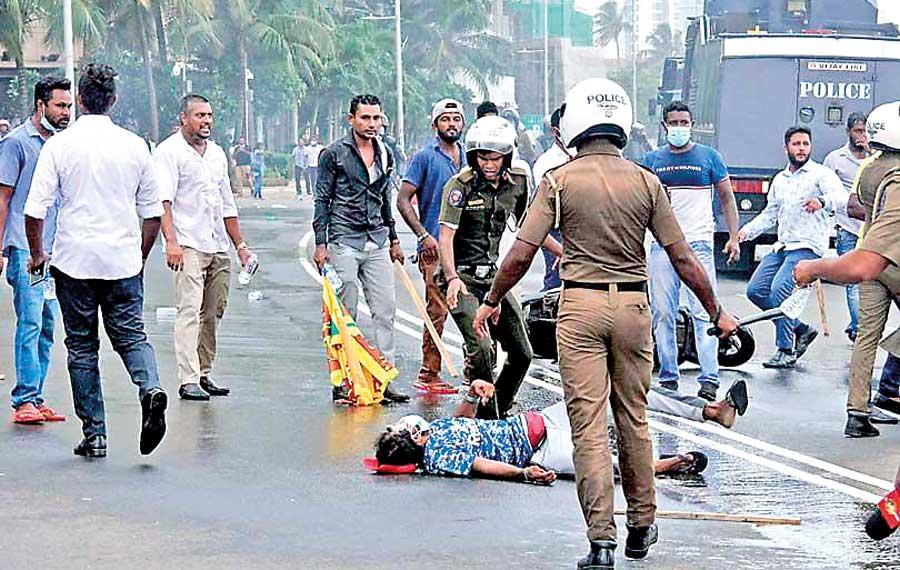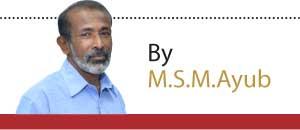Reply To:
Name - Reply Comment

When pro-government violence begot anti-government violence on May 9, Mahinda Rajapaksa before stepping down as the Prime Minister in a tweet said that violence begets violence, while calling for restraint.
violence, while calling for restraint.
Ironically, it was his supporters who carried out violence first against a group of people who were protesting against the government for a month since April 9 in Galle Face Green. And it was that violence that begot another wave of violence against those attackers and the government politicians.
Whom did he send the message of non-violence to? It was clear he wanted to pass this message to those who retaliated his supporters and not to those who started violence on that day which turned out to be fateful to him. Didn’t he know that thousands of his supporters who had been brought from various parts of the country to Temple Trees going out to attack the protestors? He knew indeed. But he miscalculated the support that the protestors had drawn from the general public. The protestors had and still have become the voice of the masses who suffer from the current economic crisis and they draw immense support from the people from all parts of the island.
Now, there seems to be several views on violence and retaliation. One group who support the victims of the initial attack, especially as the victims were pushed towards the wall by the law enforcement authorities by their inaction and bias towards the perpetrators of initial attack, argue that it is the retaliation that meted out justice to the victims. Another group totally ignores the initial attack and only see the retaliation. A third group is of the view that retaliation too would invite revenge in turn and lead to never ending cycle of violence. Another group, the largest in the society, condemns violence - initial or retaliation - perpetrated by others and not by them or people on their side.
"The protestors had and still have become the voice of the masses who suffer from the current economic crisis and they draw immense support from the people from all parts of the island"
What would have been the situation now, hadn’t the protestors at Galle Face and those admired them retaliated against the supporters of the former Prime Minister? Definitely the protest site would have been cleared of the protestors and the main activists of the site would have been hunted down by the police and the goons of the Sri Lanka Podujana Peramuna (SLPP) leaders. Protestors who were against the shortages of fuel and cooking gas across the country would have been cracked down on, using CCTV footages, social media posts and the footages of mainstream media, even if they had not resorted to violence.
Mahinda Rajapaksa had a worst track record of suppression of agitators as President. Emblematic among them were the crack down on the employees of the Katunayake Free Trade Zone in 2011 where an employee was shot dead, the brutal attack by police on the demonstrating fishermen in 2012 which killed one person and the killing of three people by the army during a protest by the residents of Rathupaswala, Weliweriya demanding pure drinking water in 2013.
The re-establishment of unhindered and unchallenged writ of Rajapaksas through a similar situation might have been in his mind when he brought thousands of his supporters including thugs to Temple Trees on May 9.
It would have in fact been realized, hadn’t the protestors and the people of areas adjacent to Galle Face retaliated immediately. It would have then been a consolation to President Gotabaya Rajapaksa as well. Mahinda Rajapaksa who was apparently instrumental to the May 9 mayhem would not have resigned as Prime Minister. No politician would have been arrested for the attack on Galle Face protestors.
Then the same old group who is responsible for the current economic and resultant political mess would have been in the saddle, justifying all their actions. President Gotabaya Rajapaksa would not have consented to reintroduce the provisions of the 19th Amendment to the Constitution. He is now even prepared to support the total abolition of executive Presidency.
Chamal Rajapaksa, the former Speaker and the eldest of the Rajapaksa brothers, referring to the humiliation suffered by former Prime Minister Mahinda Rajapaksa told Parliament on May 19 that his younger brother should have retired after the end of his second term of Presidency. “This is what happens when we become greedy for power and posts and we must learn to give up things at the right time, otherwise we would have to face this kind of sufferings” he said. Would he have given this piece of advice to his brother had the outcome of the attack on the Galle Face been otherwise?
Ironically, Chamal Rajapaksa was the Speaker of the Parliament when the 18th Amendment to the Constitution which removed the limit of Presidential terms was passed in 2010 and it was well-known then that the limit was done away with for Mahinda Rajapaksa to become the President at least for the third time. He should have given this advice to his younger brother twelve years ago!
All these outcomes justify the retaliation. The leaders of the Janatha Vimukthi Peramuna (JVP) responding to the attack on Galle Face and the aftermath say that one should not expect civilized reaction to uncivilized actions. But it was also violence, unlawful and particularly burning down of houses of politicians and killing people including a Parliamentarian is excessive and disproportionate to the initial goon attack, despite the justifiability of immediate reprisal against the goons who attacked the peaceful protestors.
Violence, once breaks out, is always prone to deviate from its original course and turn into a looting spree or a communal riot, as happened countrywide in Sri Lanka in 1983 and 1987. And it is also natural for various unscrupulous elements to take advantage of violence and unrest. It was the anger among the Sinhalese people against the government of J.R.Jayewardene over the killing of 13 soldiers by the LTTE in Jaffna on July 23, 1983 that turned into a week-long ant-Tamil pogrom combined with looting shops and houses, irrespective of who the owners of them were.
"The re-establishment of unhindered and unchallenged writ of Rajapaksas through a similar situation might have been in his mind when he brought thousands of his supporters including thugs to Temple Trees on May 9"
Similarly, the violent protests against the Indo-Lanka Accord and the induction of the so-called Indian Peace Keeping Force (IPKF) in Sri Lanka on July 29, 1987 turned their course within hours and looting overshadowed the original cause of protests. The unrest brought the country to a standstill, except for burning and looting government buildings taking place day and night, for about four days. If a situation similar to that of 1983 and 1987 had arisen after the May 9 incidents, thousands of people would have been left without food for months under the present economic crisis.
The JVP leaders claim that the real perpetrators of many of the allegations leveled against their party during their two insurrections - in 1971 and 1988/89 - would have been exposed immediately, had there been social media during those days. Again, the suggestion is that violence, once broke out is prone to be used by people with vested interests and it might totally eclipse the real issue behind the initial unrest.
This does not mean that one does not have the right to defend and protect him/herself from violence which would most probably be reprisal, especially when the law enforcement authorities are visibly taking side with the perpetrators of violence. However, it is a dangerous move that might create a totally unexpected situation.
Usually, people decry violence selectively as happened after the May 9 incidents. Government politicians except for a few, did not condemn the attack on the peaceful protestors but only denounced the arson attack on the houses of politicians while many Opposition and the anti-government groups did the other way around.
All in all, given the outcome of the retaliation against the goons who attacked the Galle Face protestors and the experience the country gained in 1983 and 1987, it would be difficult for anyone to hold a common stance on violence applicable to any circumstance.